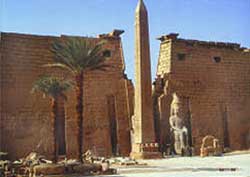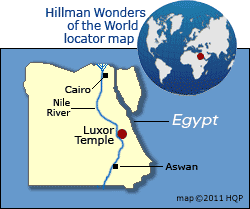



Luxor Temple
Travel tips you can trust


Why
Luxor Temple
is special
It is noted for its massiveness, historical importance, and well-preserved soaring columns.
Top 5
Luxor Temple
attractions
 Entrance Pylon
Entrance Pylon
Two jumbo Rameses II statues stand in front of this imposing gateway, as does a lofty obelisk.
 Courtyards
Courtyards
The Inner and the Rameses II courtyards are enclosed by majestic columns.
 Colonnade
Colonnade
This processional path links the two courtyards and is impressively flanked by seven giant columns on either side.
 Hyperstyle
Hyperstyle
32 towering, tightly spaced columns create an awesome scene.
 Inner Sanctum
Inner Sanctum
Small shrines and chapels are packed into the far end of Luxor Temple.
Also see the Avenue of the Sphinxes just outside Luxor Temple. It's d ramatically lined with sphinx statues and once reached Karnak Temple.
More
Luxor Temple
tips and insights
 History in bri ef
History in bri ef
In the 14th century BC, mighty Amenhotep III built a new Luxor Temple over an existing religious structure.
Additions were subsequently made by others, including Alexander the Great.
But it was Rameses II in the 13th century BC who commissioned the greatest changes: The Entrance Pylon and his courtyard.
Eventually Father Time buried the temple and town folk constructed buildings over the hidden wonder. Archaeological excavations began in the early 19th century.
 Pointers
Pointers
 Explore this wonder
both during the day and at night (when the ruins and reliefs are floodlit).
Explore this wonder
both during the day and at night (when the ruins and reliefs are floodlit).
 Come in early morning
or late afternoon to mitigate the crowd factor and (in summer) the scorching sun.
Come in early morning
or late afternoon to mitigate the crowd factor and (in summer) the scorching sun.
 Location in Egypt
Location in Egypt

Read about each of Egypt's top 7
 Pyramids of Egypt at Giza
Pyramids of Egypt at Giza
 Karnak Temple
Karnak Temple
 Nile River Cruise
Nile River Cruise
 Egyptian Museum
Egyptian Museum
 Valley of the Kings
Valley of the Kings
 Abu Simbel
Abu Simbel
 Luxor Temple
Luxor Temple


World's Top 100 Wonders
World's Top 1000 Wonders
Site map
My credentials
About my website and criteria
Reader testimonials



